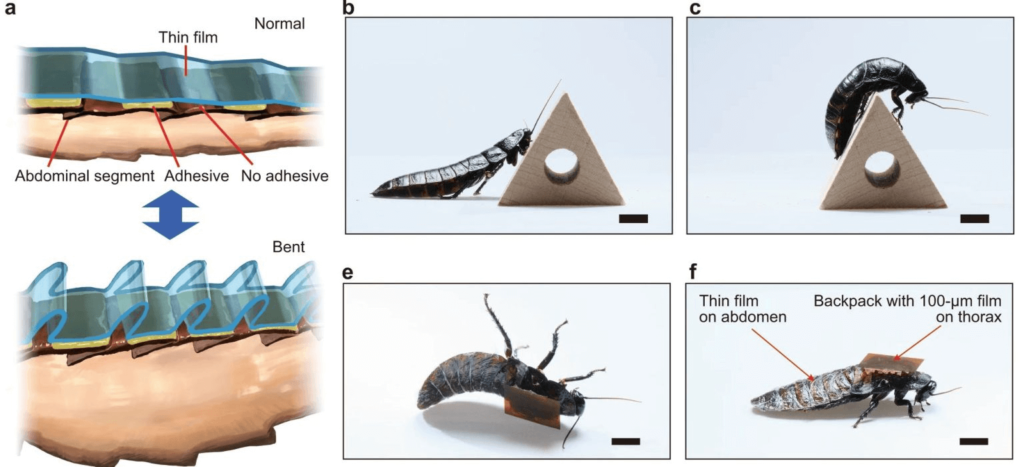Researchers at Japan's RIKEN Center for Emergent Matter Science (CEMS) have used 3D printing to create a device that turns cockroaches into remote-controlled cyborgs.
3D printed from a stretchy polymer that allows it to follow the curved surface of the insect's thorax, the team's small backpack allows for the carrying of a motion control module and solar cell. These, in turn, provide users with a means to electrically stimulate the circus cockroach to issue navigational commands and prevent it from breaking free by keeping its battery charged by the sun.
"Keeping the battery sufficiently charged is essential - nobody wants a suddenly out-of-control team of cyborg cockroaches wandering around," says Masataka Sasabe of the RIKEN Research Institute. “Although it is possible to build docking stations for battery recharging, the need to return and recharge could disrupt time-sensitive missions. Therefore, the best solution is to include a built-in solar cell that can continuously ensure that the battery remains charged.

Image via RIKEN CEMS.
Cyborgs insects for search and rescue ?
Citing research on cyborg insects by Nanyang Technological University conducted last year, CEMS scientists say the controllable bugs have significant potential as future urban search and rescue vehicles. In theory, the team believes the tiny creatures could be used to enter areas too dangerous for humans to access, but added that storing enough charge to power small control devices "remains a challenge."
So that such cyborgs do not have to constantly return to the charging base, the scientists propose that they be fitted with energy harvesting devices capable of recharging on the fly. While the highest recorded power output of an enzymatic biofuel cell is 333 μW, and that proved sufficient to control cockroaches in previous studies, the CEMS team now says that solar power can increase that number to 10 mW.
With that in mind, the researchers' project has led them to focus on finding ways to attach solar cells and navigation devices to the insects without giving them too much weight to carry and compromising their "basic behavioral capabilities."
"In order to integrate devices into small animals with limited surface areas and to carry payloads, a device design and a large-area solar cell integration strategy are required," the CEMS scientists explain in their research paper. "Since the power output of the solar cell is proportional to the area, both the loading of the device and the contact between the device and the movable joints significantly degrade the movement capabilities."

Image via RIKEN CEMS.
Turning cockroaches into cyborgs
To maximize the success of their battery- and PCB-carrying device, the scientists designed it to fit the Madagascar cockroach, one of the world's largest, with a body up to 7 centimeters long. Manufacturing their backpack using Formlabs' Form 3 3D printer and Elastic 50A material gave it the flexibility to conform to the insect's curved body while also making it an ideal mounting point.
On their backpack, the researchers found they were able to attach a 4 µm-thick organic solar cell module to one of the insect's abdomens, which after amplifying the circuit gave an output of 4.2 V. This charge could then be used to power of a wireless module capable of receiving signals from an external server and making the cockroach comply with them by electrical shocks to its navigation cercus.
In early attempts to use the device to control cockroaches through obstacle courses, the solar cells turned out to be too thick or rigidly attached, in a way that slowed them down and made it difficult for them to self-regulate. However, by replacing the 3 µm-thick film that holds the cell in place with a resin adhesive, the team found that their insect cyborgs were much more nimble.
As for charging performance, testing has also shown that the solar cell module is capable of powering the device for two hours after a full charge. As a result, the researchers conclude that their approach is an effective "design strategy for mounting electronics" on cockroaches that could help "expand the range of activity and realize diverse functions for cyborg insects" moving forward.

Image via RIKEN CEMS.
Creating cyborg cockroaches may be part of 3D printing research, but the technology has also been used in the development of devices to control the human mind and treat the brain. Renishaw has made significant progress with its 3D-printed neuroinfusion drug delivery device , a platform it is developing with Herantis Pharma to treat Parkinson's disease, which has already gone through clinical trials.
Elsewhere, in a project carried out at Aston University last year, scientists explored the potential of 3D bioprinting in the treatment of neurological conditions. As part of the EU-backed Meso-Brain project, the team is generating personalized 3D-printed neurons derived from stem cells that can be used to develop a new generation of disease modeling and testing tools.
0 Comments